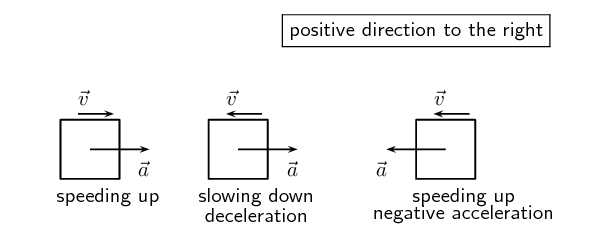An athlete is accelerating uniformly from an initial velocity of \(\text{0}\) \(\text{m·s$^{-1}$}\) to a final velocity of \(\text{4}\) \(\text{m·s$^{-1}$}\) seconds. Calculate his acceleration. Let the direction that the athlete is running in be the positive direction.
21.4 Acceleration
|
Previous
21.3 Speed and velocity
|
Next
21.5 Instantaneous velocity and speed
|
21.4 Acceleration (ESAGY)
- Average acceleration
-
Average acceleration is the change in average velocity divided by the time taken.
Quantity: Average acceleration (\(\vec{a}_{av}\)) Unit name: metre per second squared Unit symbol: \(\text{m·s$^{-2}$}\)
Acceleration is a measure of how fast the velocity of an object changes in time. If we have a change in velocity (\(\Delta \vec{v}\)) over a time interval (\(\Delta t\)), then the average acceleration (\({\vec{a}}_{av}\)) is defined as:
\begin{align*} \text{average acceleration (in } \text{m·s$^{-2}$} \text{)} & = \frac{\text{change in velocity (in } \text{m·s$^{-1}$} \text{)}}{\text{change in time (in } \text{s} \text{)}} \\ \vec{a}_{av} & = \frac{\Delta \vec{v}}{\Delta t} \end{align*}We only deal with problems with constant acceleration. This means that the average acceleration and the instantaneous acceleration are the same. To make things simpler we will only talk about acceleration and not average or instantaneous. This is represented as \(\vec{a}\). We can also have the magnitude of the acceleration. This is:
\[a = \frac{\Delta \vec{v}}{\Delta t}\]Acceleration is a vector. Acceleration does not provide any information about the motion, but only about how the motion changes. It is not possible to tell how fast an object is moving or in which direction from the acceleration alone.
Like velocity, acceleration can be negative or positive. We see that when the sign of the acceleration and the velocity are the same, the object is speeding up. If both velocity and acceleration are positive, the object is speeding up in a positive direction. If both velocity and acceleration are negative, the object is speeding up in a negative direction.
Avoid the use of the word deceleration to refer to a negative acceleration. This word usually means slowing down and it is possible for an object to slow down with both a positive and negative acceleration, because the sign of the velocity of the object must also be taken into account to determine whether the body is slowing down or not.
We can see this in the following diagram:

If velocity is positive and acceleration is negative, then the object is slowing down. Similarly, if the velocity is negative and the acceleration is positive the object is slowing down. This is illustrated in the following worked example.
Worked example 2: Acceleration
A car accelerates uniformly from an initial velocity of \(\text{2}\) \(\text{m·s$^{-1}$}\) to a final velocity of \(\text{10}\) \(\text{m·s$^{-1}$}\) in \(\text{8}\) seconds. It then slows down uniformly to a final velocity of \(\text{4}\) \(\text{m·s$^{-1}$}\) in \(\text{6}\) seconds. Calculate the acceleration of the car during the first \(\text{8}\) seconds and during the last \(\text{6}\) seconds.
Choose a reference frame
We choose the point where the car starts to accelerate as the origin and the direction in which the car is already moving as the positive direction.
Identify what information is given and what is asked for
Consider the motion of the car in two parts: the first \(\text{8}\) seconds and the last \(\text{6}\) seconds.
For the first \(\text{8}\) seconds:
\begin{align*} \vec{v}_{i} & = \text{2}\text{ m·s$^{-1}$} \\ \vec{v}_{f} & = \text{10}\text{ m·s$^{-1}$} \\ t_{i} & = \text{0}\text{ s} \\ t_{f} & = \text{8}\text{ s} \end{align*}For the last \(\text{6}\) seconds:
\begin{align*} \vec{v}_{i} & = \text{10}\text{ m·s$^{-1}$} \\ \vec{v}_{f} & =\text{4}\text{ m·s$^{-1}$} \\ t_{i} & =\text{8}\text{ s} \\ t_{f} & =\text{14}\text{ s} \end{align*}Calculate the acceleration.
For the first \(\text{8}\) seconds:
\begin{align*} a& = \frac{\Delta v}{\Delta t} \\ & = \frac{\text{10}\text{ m·s$^{-1}$}}{\text{8}\text{ s} - \text{0}\text{ s}} \\ & = \text{1}\text{ m·s$^{-2}$} \end{align*}For the next \(\text{6}\) seconds:
\begin{align*} a& = \frac{\Delta v}{\Delta t} \\ & = \frac{\text{4}\text{ m·s$^{-1}$}}{\text{14}\text{ s} - \text{8}\text{ s}} \\ & = -\text{1}\text{ m·s$^{-2}$} \end{align*}During the first \(\text{8}\) seconds the car had a positive acceleration. This means that its velocity increased. The velocity is positive so the car is speeding up. During the next \(\text{6}\) seconds the car had a negative acceleration. This means that its velocity decreased. The velocity is positive so the car is slowing down.
Acceleration
A bus accelerates uniformly from an initial velocity of \(\text{15}\) \(\text{m·s$^{-1}$}\) to a final velocity of \(\text{7}\) \(\text{m·s$^{-1}$}\) in \(\text{4}\) seconds. Calculate the acceleration of the bus. Let the direction of motion of the bus be the positive direction.
An aeroplane accelerates uniformly from an initial velocity of \(\text{100}\) \(\text{m·s$^{-1}$}\) to a velocity of \(\text{200}\) \(\text{m·s$^{-1}$}\) in \(\text{10}\) seconds. It then accelerates uniformly to a final velocity of \(\text{240}\) \(\text{m·s$^{-1}$}\) in \(\text{20}\) seconds. Let the direction of motion of the aeroplane be the positive direction.
-
Calculate the acceleration of the aeroplane during the first \(\text{10}\) seconds of the motion.
-
Calculate the acceleration of the aeroplane during the next \(\text{20}\) seconds of its motion.
|
Previous
21.3 Speed and velocity
|
Table of Contents |
Next
21.5 Instantaneous velocity and speed
|
